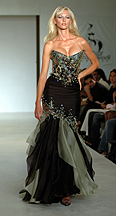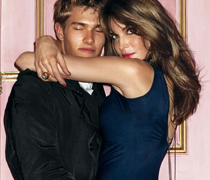As a living art, fashion is open to multiple readings, and blog.mode: addressing fashion at The Metropolitan
Museum of Art from December 18, 2007, through April 13, 2008, presents approximately 40 costumes and accessories dating from
the 18th century to the present — all recent Metropolitan Museum acquisitions — and invites the public to share
their reactions via a blog on the Museum's website. Over the duration of the exhibition, which will take place in The Costume
Institute galleries, individual costumes and accessories will be posted on the blog periodically with commentary from curators
Harold Koda and Andrew Bolton, and, where relevant, from contemporary designers.
The blog is the Metropolitan Museum's first foray into the blogosphere, and can be accessed from the "Special Exhibitions"
page of the Museum's website (www.metmuseum.org). Visitors can respond to the postings from anywhere during the run of the
exhibition, including a "blogbar" of computer terminals in the exhibition galleries.
The exhibition is made possible by Manolo Blahnik.
"Fashion, both a reflection and an expression of the zeitgeist, is open to a wide range of interpretations," said Harold
Koda, Curator in Charge of The Costume Institute. "While painting and sculpture can sometimes seem to be at an intimidating
conceptual remove, fashion is so familiar, so ubiquitous to our experience that it is inherently and immediately accessible.
Individuals who might shy away from commenting on the merits of a Juan Gris or Henry Moore will readily disclose their thoughts
on a gown by John Galliano or a mule by Manolo Blahnik. Unlike its 'high art' siblings, fashion, even in its most extreme
and avant-gardist expression, draws us in with its personal relevance."
Garments acquired during the past seven years — from a 1730s English man's suit of red wool lavishly embroidered
with gilt paillettes to a 2005 John Galliano for Christian Dior deconstructed ball gown — will be presented in chronological
order to stimulate debate about the vicissitudes of fashion. Acquisitions of note come from such houses as Adrian, Azzedine
Alaïa, Miguel Adrover, Geoffrey Beene, Manolo Blahnik, Hussein Chalayan, Gabrielle 'Coco' Chanel, Comme des Garçons, Christian
Dior, Jean Paul Gaultier, Rudi Gernreich, Charles James, Donna Karan, Helmut Lang, Alexander McQueen, Issey Miyake, Hamish
Morrow, Paul Poiret, Zandra Rhodes, Yves Saint Laurent, Elsa Schiaparelli, Junya Watanabe, Vivienne Westwood, Charles Frederick
Worth, and Yohji Yamamoto.
Notable acquisitions include a Miguel Adrover ensemble from 2001 made from Quentin Crisp's old mattress, which Adrover
found discarded outside the writer's Lower East Side apartment. A fashionable aristocrat's opulently beaded dress from 1910,
at the end of the Austro-Hungarian Empire — which the museum purchased in 2003 from a London auction house — was
later discovered by The Costume Institute's conservator to have a 24-carat-gold lining inside each bead. This dress represents
the end of an era: a pre-modern moment before women's bodies were liberated from the constraints of corsets. In an avant-garde
ode to the corset, Jean Paul Gaultier's 2001 "Des Robes qui se Dérobent," a strapless pale-pink silk satin corset dress with
a silk tulle overlay embroidered with seed pearls, has laces that crisscross down an open back, pooling into a train of ribbons.
The haute couture beadwork contrasts with the near-naked back, with its shocking rear view.
A jersey dress — from Comme des Garçons's all-black Paris debut collection of 1983 — was donated by Muriel
Kallis Steinberg Newman, whose preeminent collection of Abstract Expressionist art is now on display at the Metropolitan Museum
through February 3, 2008. With its reference to Chanel's "little black dress" and its denial of an overt female sexuality,
the dress epitomizes the art collector's movement away from the haute couture toward an increasing originality and experimentalism,
and suggests the gutsiness of both client and designer.
A 1947 dress by Adrian provides an ideal example of surrealism on two levels – first in the textile Salvador Dalí
created for Wesley Simpson that is printed with surrealist rocks and boulders, and also in the black shoulder insert (a signature
Adrian technique) that forms a woman's profile on the left shoulder.
Two pairs of thigh-high leather boots made by a Parisian bottier in the 1920s reveal 4.5-inch heels, predating their
emergence in high style by at least 20 years. The boots, worn by demimondaines, provide evidence of the influence of marginal
and fetishistic fashions on the mainstream.
A Simon Costin necklace invokes the dark sensibility of Elizabethan literary imagery. Entitled the Incubus Necklace,
it incorporates five vials of human semen, from which dangle baroque pearls. It was last seen in the Met's AngloMania exhibition
in 2005, where it was shown with a Vivienne Westwood gown inspired by a portrait of Queen Elizabeth I, and where the necklace
served as an ironic commentary on Elizabeth's status as the widely hailed "Virgin Queen."
This selection of new acquisitions reflects a fraction of The Costume Institute's collection of more than 30,000 costumes
and accessories spanning five continents and as many centuries. blog.mode: addressing fashion continues The Costume
Institute's dedication to the acquisition, exhibition, and interpretation of historical and contemporary fashion. It also
reflects the Museum's mission to actively seek out and obtain masterworks from all eras and corners of the world.
The exhibition is organized by Harold Koda, Curator in Charge, and Andrew Bolton, Curator, both of the Metropolitan Museum's
Costume Institute. Exhibition design is by Michael Langley, graphic design by Sophia Geronimus, and lighting design by Clint
Coller and Richard Lichte, all of the Metropolitan Museum's Design Department. Chris Paulocik is the Conservator for The Costume
Institute.
A book, blog.mode: addressing fashion, published after the close of the exhibition by The Metropolitan Museum of
Art and distributed by Yale University Press. It will include photographs of all of the garments and accessories from the
exhibition, along with curatorial commentary and excerpts from the blog.
The blog for the exhibition will go online at www.metmuseum.org on December 18, 2007, and will accept new comments until
April 13, 2008, when the exhibition closes.
Education programs will be presented in conjunction with the exhibition, which is also featured on the Museum's website
at www.metmuseum.org .





